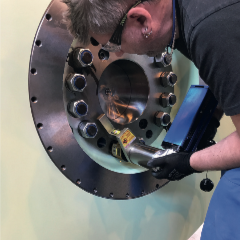Everyone understands that there are quite a number of critical bolted connections in a wind turbine. Inaccurate bolt tension can easily turn into a wind turbine engineer’s nightmare. Luckily the industry has developed a number of solutions to overcome bolting issues.
With 25 years’ experience in gear reduction torque tools, RAD Torque Systems has become the global market leader in this technology. Rather than using hydraulic pressure to fasten bolts, all RAD tools use a planetary gearbox to reach torques up to 16.500 Nm. Torque operations are significantly faster with this technology and far more ergonomic. The use of RAD tools can save up to one day of installation time on an average wind turbine.
Laboratory tool calibration versus bolting in the field
Conventional torque tools are calibrated on a simulation test bench. One of the biggest challenges in the bolting industry is to optimize the differences between this simulation and the actual bolts used in the field. An often used terminology is the spectrum of hard and soft joints. Torque tools are therefore calibrated according to the ‘hardness’ of the joint so that they match as closely as possible the bolted joint as used in the field.
If needed, any occurring deviations can be adjusted in the field. These deviations can occur because of several reasons but mostly because of different reaction arms used and different bolt specifications.
For precise field checks, RAD has developed the so-called SmartSocket™; a precise torque measuring device (<1% accuracy) that allows the field engineer to measure the applied torque on the bolt. Any deviation can be viewed on screen and can be used to adjust the setting of the torque tool. A ‘field calibration’ is the result.
Tool accuracy – repeatability
Once the optimisation has been found between the calibration and the ‘field work’, the next step is the tool’s performance. The best way of measuring this is repeatability: the range of deviation in the torque when doing multiple torque cycles. RAD tools have a repeatability of 2 to 4%, depending on the tool type. The E-RAD is the best performing tool with only 2%. In practice this means that at a setting of 10.000 Nm the output torque will range from 9.800 Nm to 10.200 Nm.






























